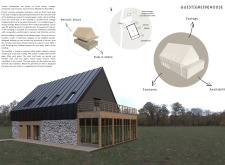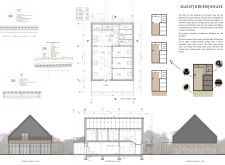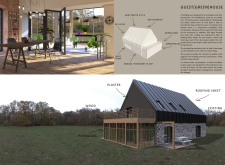5 key facts about this project
Sustainable materials and innovative systems characterize the architectural design, optimizing energy efficiency and resource management. The use of stone in the lower façade provides thermal mass while contributing to the building's durability. The upper sections utilize wood and plexiglass, allowing for natural light infiltration, creating an inviting atmosphere, and enhancing user experience. The roofing system is designed to absorb solar energy, supporting water heating via PEX pipes, thus reducing operational costs.
Design Innovations that Enhance Functionality
The Guest Green House incorporates unique design elements that distinguish it from conventional residential or community-building projects. The integration of a comprehensive gray water recycling system allows for sustainable water use, channeling reused water from sinks and showers into garden irrigation. This innovative approach emphasizes resource conservation while fostering ecological responsibility.
The building layout prioritizes accessibility, featuring wide pathways and thoughtful connections between spaces to support users with disabilities. It encourages social interaction through the design of communal areas and private rooms, ensuring versatility in relation to individual or group activities. This thoughtful arrangement promotes an inclusive environment, catering to a diverse range of occupants and uses.
Architectural Considerations and Design Details
The architectural design employs a variety of features that enhance its overall functionality. The ground floor is organized as a communal zone, transitioning into private accommodations on the upper floor. This layout balances public and private experiences, catering to different audience needs.
The greenhouse serves as a central feature, supporting plant growth while also acting as a thermal regulator for the building. The design's embrace of natural systems extends to the planting strategy, which complements indoor climate management.
In summary, the Guest Green House exemplifies a practical and functional approach to sustainable architecture. With its commitment to ecological integrity, cost-effective materials, and inclusivity, the project stands as an example of modern sustainable design principles.
For more detailed insights into the project, including architectural plans, sections, and further design elements, readers are encouraged to explore the complete project presentation. This deeper examination will provide a greater understanding of the architectural ideas and unique features that define this innovative project.


























